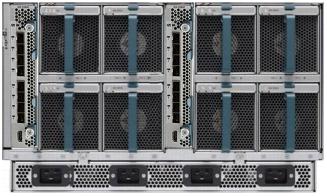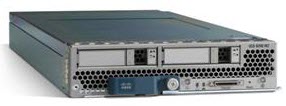Cisco’s Unified Computing System (UCS) provides a solution that integrates the server, network and storage resources that are used within a modern datacenter. It does this through the deployment of equipment that is managed through a single management system (UCS Manager). The idea is to save on a number of different costs within the data center, including equipment and support costs. When deploying a system that is closely integrated and provides the ability to provision the server, network and storage resources in one step, support costs can be reduced and configuration errors avoided. To create this system there are a number of different components that are deployed, including fabric interconnects, blade server chassis, fabric extenders and the blade servers themselves. This article takes a look at these different components, what they are and what they provide to the UCS solution.
UCS 6100 Series Fabric Interconnects
At the center of UCS is the UCS 6100 Fabric Interconnect, it provides the management and communications backbone for the entire solution. For management, the UCS Manager software is embedded in the appliance itself. For communications, the appliance offers lossless 10 Gigabit Ethernet and Fiber Channel over Ethernet (FCoE) functionality and connectivity. Each of the 10 Gigabit ports on the appliance offers a line-rate, lossless connection regardless of packet size or services configured.
There are three different models of the Fabric Interconnect that are currently offered: these include the UCS 6120XP 20-Port, UCS 6140XP 40-Port and 6248UP 32-Port appliances.
Table 1 below shows a comparison of these three appliances:
| UCS 6120XP | UCS 6140XP | UCS 6248UP | |
| Form Factor | 1 RU | 2 RU | 1 RU |
| Number of fixed 10-Gigabit Ethernet and FCoE Small Form-Factor Pluggable Plus (SFP+) ports | 20 | 40 | 32 |
| Throughput | 520 Gbps | 1.04 Tbps | 960 Gbps |
| Expansion Modules | 1 | 2 | 1 (Supports the new 16-Port 10-Gbps Expansion Module) |
Table 1: UCS 6120XP 20-Port, UCS 6140XP 40-Port and 6248UP 32-Port Appliance Comparison
The fabric interconnect acts as the central location to connect together the different blade chassis. In total, the UCS supports up to 40 different blade server chassis and 320 half-width blade servers.
Figure 1 below shows a 6120XP appliance:

Figure 2 shows a 6140XP appliance:

Figure 3 shows a 6248UP appliance:

UCS 5100 Series Blade Server Chassis
Cisco’s 5108 blade server chassis is 6 RU and is able to house up to eight half-width or four full-width UCS B-Series blade servers. Power is provided by up to four hot-swappable power supplies that can be configured in an N+1 redundant configuration. Two fabric extenders are able to be installed in the chassis rear to support multiple connections to the fabric interconnects. Figure 4 shows a 5108 blade server chassis front:
Figure 5 shows a 5108 blade server chassis rear with UCS 2200 Fabric Extenders (discussed next):

UCS 2100 and 2200 Fabric Extenders
The UCS fabric extenders connect into the rear of the UCS 5100 Series blade server chassis and provide both external connection to the fabric interconnects and internal connection to each of the blade server slots. It is important to note that the fabric extenders do not switch traffic, this is offloaded to the fabric interconnects. Currently, two different fabric extenders exist: the 2104XP and the 2208XP. Table 2 below shows the different characteristics of each.
| UCS 2104XP | UCS 2208XP | |
| External Ports | 4-10 Gbps SFP+ ports | 8-10 Gbps SFP+ ports |
| Internal Ports | 10 – 10 Gbps Ethernet ports (Midplane – One per half width slot) | 32 – 10 Gbps Ethernet ports (Midplane – 4 per half width slot) |
| Total I/O Available to the Chassis | 80 Gbps (per pair of extenders) | 160 Gbps (per pair of extenders) |
Table 2: UCS 2104XP and UCS 2208XP Fabric Extenders Comparison
UCS B-Series Blade Servers
There are a number of different options when it comes to choosing the blade servers to connect into the 5108 chassis. Table 3 below shows the different options available:
| B200 M2 | B250 M2 | B230 M1 | B230 M2 | B440 M1 | B440 M2 | |
| Processor Sockets | 2 | 2 | 2 | 2 | 4 | 4 |
| Supported Processors | Intel Xeon 5600 Series | Intel Xeon 5600 Series | Intel Xeon 6500 or 7500 Series | Intel Xeon E7-2800 Series | Intel Xeon 7500 Series | Intel Xeon E7-4800 Series |
| Memory Slots | 12 | 48 | 32 | 32 | 32 | 32 |
| Memory Capacity | 192 GB | 384 GB | 256 GB | 512 GB | 512 GB | 512 GB |
| Memory Sizes Supported | 4,8,and 16 GB DDR3 | 4 and 8 GB DDR3 | 4 and 8 GB DDR3 | 4,8,and 16 GB DDR3 | 4,8,and 16 GB DDR3 | 4,8,and 16 GB DDR3 |
| Memory Speeds Supported | 1066 and 1333 MHz | 1066 and 1333 MHz | 1066 MHz | 1066 MHz | 1066 MHz | 1066 MHz |
| Max Internal Storage | 1.2 TB | 1.2 TB | 128 GB (SSD) | 200 GB (SSD) | 2.4 TB | 2.4 TB |
| RAID Modes Supported | 0,1 | 0,1 | 0,1 | 0,1 | 0,1,5,6 | 0,1,5,6 |
| Mezzanine I/O Adapter Slots | 1 | 2 | 1 | 1 | 2 | 2 |
| Max I/O Throughput | 20 Gbps | 40 Gbps | 20 Gbps | 20 Gbps | 40 Gbps | 40 Gbps |
| Form Factor | Half | Full | Half | Half | Full | Full |
Table 3: UCS B-Series Blade Server Options
Figure 6 shows a B200 M2 half width blade server:

Figure 7 shows a B440 M1 full width blade server:

Mezzanine I/O Adapters provide the ability to support a number of different network configurations including multiple 10 Gigabit Ethernet or Host Bus Adapters (HBAs). There are a number of different options that will not be reviewed in this article but had to be mentioned given the content of this article.
The UCS solution offers an innovative, very expandable option that would easily provide for even the largest of organizations. Those organizations looking into building a new data center or upgrading their existing data center should take a hard look at when Cisco’s UCS solution can provide and how it affects the TCO of the data center in general, especially as it relates to on-going support costs.
—Reference from petri.co.il by Sean Wilkins
More Cisco UCS Tips:
Cisco Buying Tips: Cisco UCS Server
Cisco and NetApp Waggle Shrunken ExpressPod at Hitachi and Friends
New Cisco System Helps Customers Build Clouds, Deploy Business Applications Faster
Cisco’s UCS 3.0 Unveiled with Xeon Servers, Unified Management

